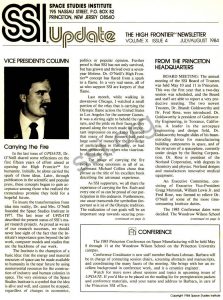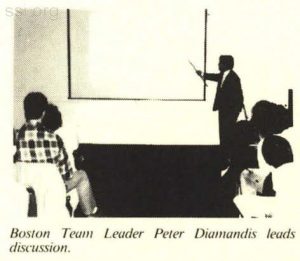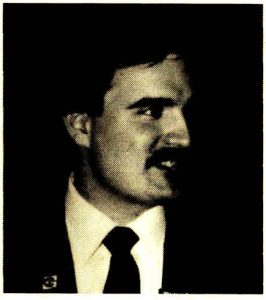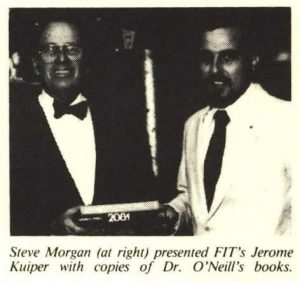
SPACE STUDIES INSTITUTE
195 NASSAU STREET, P.O. BOX 82
PRINCETON, NEW JERSEY 08540
[[librarian note: This address is here, as it was in the original printed newsletter, for historical reasons. It is no longer the physical address of SSI. For contributions, please see this page]]
SSI UPDATE
THE HIGH FRONTIER™ NEWSLETTER
VOLUME X ISSUE 4 JULY/AUGUST 1984
PRESIDENT’S COLUMN
Carrying the Fire
In the last issue of UPDATE, Dr. O’Neill shared some reflections on the first fifteen years of effort aimed at opening the High FrontierSM for humanity. Initially, he alone carried the spark of those ideas. Later, through publication in the scientific and popular press, these concepts began to gain acceptance among those who realized the tremendous promise they hold for a hopeful future.
To insure the transformation from idea into reality, Dr. and Mrs. O’Neill founded the Space Studies Institute in 1977. The last issue of UPDATE described the present status of SSI’s major research projects. As proud as we are of our research successes, we should never lose sight of the fact that the Institute’s importance goes beyond the lab work, computer models and studies that are the backbone of our work.
The Institute is the champion of a basic idea: that the energy and material resources of space can be made available to humanity in the near future by using nonterrestrial resources for the construction of industry and human colonies in space. The very existence of the Space Studies Institute is a symbol that the idea is alive and well, and cannot be stopped, regardless of changes in economics, politics or popular opinion. Further proof is that SSI has not only survived, but has grown and thrived over a seven year lifetime. Dr. O’Neill’s High FrontierSM concept has flared from a spark to a flame. In a very real sense, all of us who support SSI are keepers of that flame.
Last month, while walking in downtown Chicago, I watched a small portion of the relay that is carrying the Olympic flame across the United States to Los Angeles for the summer Games. It was a stirring sight to behold the runners, and the pride on their faces as they passed along the torch made an important impression on me. Later I learned that many of these runners had paid large sums of money for the priviledge of participating in that relay, or had been sponsored by others who vicariously shared the event.
The image of carrying the fire evokes strong emotions in all of us. Astronaut Michael Collins chose that phrase as the title of his excellent book describing the astronaut experience.
As SSI supporters, we all share the experience of carrying the fire. Each and every one of us can be proud of our participation in this endeavor. Furthermore, our cause transcends the symbolism (important as it is) of the Olympic tradition. The realization of our goals will be an important step towards securing prosperity and freedom for future generations otherwise condemned to scarcity and regimentation.
We can also take pride in knowing that our efforts in this venture are bearing fruit. The Institute’s research and Conferences are serving as the basis for further work outside of our own community of friends and supporters. High level government officials now speak openly of asteroid retrieval missions. Several research teams will hold conferences this summer about returning to the Moon.
It is especially interesting to note the growing acceptance of the High FrontierSM concept among members of the scientific community. One specific example of this trend is a debate that occurred several weeks ago between Dr. Frank Drake and Dr. Robert Rood on the question of whether or not other technological civilizations, capable of communicating with us, exist in our galaxy. Both Drake and Rood used the inevitability of space colonization as a major basis for their respective positions.
Dr. Drake maintained that technological civilizations will have extremely long lifetimes, since they will build space colonies and have the use of the resources of their entire solar systems to sustain themselves. Dr. Rood’s position was that eventually those civilizations will certainly build space colonies and will use modified colonies to move from system to system. Even at small fractions of the speed of light, his argument goes, it would take less than 40 million years for any one such civilization to spread across the entire galaxy and since this sort of activity has apparently not spread to our system, we must be the first or only intelligent civilization in the galaxy.
As pleasant and important as it is to consider the progress we have made, it is equally clear that we must take advantage of the growing interest in space to accelerate the Institute’s research and educational programs. Let’s redouble our efforts, so that our children and grandchildren will not only see that we carried the fire, but that we carried it well.
Gregg Maryniak
FROM THE PRINCETON HEADQUARTERS
BOARD MEETING: The annual meeting of the SSI Board of Trustees was held May 10 and 11 in Princeton. This was the first year that a two-day session was scheduled, and the Board and staff are able to report a very productive meeting. The two newest Trustees, Dr. Brandt Goldsworthy and Dr. Fred Rose, were introduced. Dr. Goldsworthy is president of Goldsworthy Engineering, in Torrance, California. A leader in the aerospace engineering and design field, Dr. Goldsworthy brought slides of his beamextruding device for manufacturing building components in space, and of the structure of a spaceplane, currently under design by the Boeing Corporation. Dr. Rose is president of the Norland Corporation, with degrees in chemistry and physics. Norland designs and manufactures innovative medical equipment.
An Executive Committee, consisting of Executive Vice-President Gregg Maryniak, William Lewis Jr. and Fred Rose, was formed to relieve Dr. O’Neill of some of the more timeconsuming Institute duties.
The 1985 Conference dates were decided. The Woodrow Wilson School at Princeton University will again serve as the site of the Conference, to be held May 8 through May 11, 1985.
The Board passed a resolution to compile and publish the Institute’s Five Year Plan for the industrialization of space. The Plan will be sent to all Senior Associates in a special mailing in early 1985. Watch for a summary in a future UPDATE.
WE’RE MOVING!: A decline in the local elementary school population has opened a new office space for the Space Studies Institute. For slightly less rent, SSI will be moving into twice as much space in early September. The office is located in the Johnson Park School here in Princeton. The space and location are ideal for the Institute’s needs, and the staff will host a Senior Associate reception in the new setting in the Fall. The post office box in our address will remain the same Box 82, but our street address, after September 10, will be 285 Rosedale Road, Princeton, New Jersey, 08540. The phone number will also remain the same: xxx-xxx-xxxx.
MCNEIL-LEHRER NEWS HOUR: In late July, a crew from Public Television’s McNeil-Lehrer News Hour will be in Princeton to interview Dr. O’Neill. The crew has indicated that the interview will be aired the second or third week in August. Check your local listings for time and date.
LECTURE: Two members of the SSI staff, Dr. Les Snively and VicePresident Gregg Maryniak, spoke at the New York Institute of Technology at the beginning of May. Their topic was space as the next frontier for exploration.
For those of you who’d like speakers for meetings or conferences, Dr. Snively and Mr. Maryniak have indicated that they would be willing to make similar presentations for those of you who’d like speakers for meetings or conferences. Mr. James Burke, in California, is also an excellent speaker, and Dr. Fred Rose is available in the Midwest region. Please note: any requests for lectures must come through the Princeton office.
OTV PAPER: Last summer, Princeton Aerospace Engineering student Chris Buja wrote several papers under a small grant from the Space Studies Institute. One of the papers, Orbital Transfer Vehicles, is available for $2.00. Anyone interested in purchasing a copy should send a check or money order along with name and address to:
OTV c/o SSI
Box 82
Princeton, New Jersey
08540
RESEARCH SURVEY: With this year’s Membership renewal forms, surveys were sent out asking what you would like brought before the Board of Trustees for next year’s research priorities. 318 of you responded, voting for one or more areas of research. Expansion of Mass-Driver Research received 181 votes. A second phase of Solar Power Satellite design study won 178 votes. A second chemical separation project was third with 105 votes, and space colony design was a close fourth with 104. Broadening SSI’s education programs received 73 votes. Many thanks to those of you who responded to the survey.
The 1985 Princeton Conference on Space Manufacturing will be held May 8 through 11 at the Woodrow Wilson School on the Princeton University campus.
Conference Coodinator is new staff member Barbara Lehman. Barbara will be in charge of contacting session chairs, screening abstracts and manuscripts, and coordinating the many facets of the meeting. She brings with her an excellent background in conference work, and is a ceramics engineer.
Watch for more news about sessions and topics in upcoming issues of UPDATE. If you’d like to be placed on the mailing list for preregistration packets and conference materials, send your name and address to Barbara, in care of the Princeton SSI office.
LOCAL SUPPORT TEAMS
SPACEWEEK is coming! Each local support team leader has received a package of materials for distribution during SPACEWEEK. Contact the leader nearest you to see if there are any projects you can assist. Or get some information to prepare your own booth or presentation. Teams are spread all over the country, so there should be someone nearby.
BOSTON AREA: Team leader Peter Diamandis conducted a four session series entitled “Space Industrialization: How to Get Rich Quick” in January. Topics included materials processing, mining the Moon and asteroids, satellites, transportation systems and space stations. The Boston team is also hard at work recruiting new Members and Senior Associates.

WASHINGTON, DC AREA: Utilizing some local computers, volunteers undertook a data-entry program for SSI Participants included Chris Cuddy, Eric Dahlstrom, Robert Goldenkoff, Todd Hawley, Geoffrey Holdridge, Morris Hornik, Marilyn Kirkpatrick, Dennis Mateik, Santoria Mendoza, Keith Morton, James Muncy, Jody Rawley and Geoffrey Salinger.
SAN DIEGO AREA: Drawing on a space settlement course taught by John at San Diego State University, team leader Jim Bowery and his group have assembled a number of slides for a special event planned in May. By getting together with other space interest groups in the area, Jim’s team is recruiting new Members and Associates, as well. Through the efforts of team member Dave Duemler, a presentation to the Sierra Club is underway for the fall. Work is also going forward on a public service announcement for distribution to local radio stations. Anyone in the San Diego State University faculty or student body interested in meeting with the Local Support Team, please contact Jim at xxx-xxx-xxxx.
FLORIDA AREA: In the last few busy months, team leader Steve Morgan has sent letters to the planetariums in his region, offering SSI material and presentations, drafted an article for the Florida Institute of Technology Alumni newsletter and presented copies of 2081 and The High Frontier to Dr. Jerome Kuiper, the lnstitute’s president. The Florida Support Team also awarded SSI Memberships to the winners of several local science fairs. The next few months look even more exciting.
GUEST COLUMN
Manin Rothblall is GEOSTAR’s Vice President for Regulatory Affairs, who has been interested in space since childhood. He holds degrees in business and law from UCLA, and continues to broaden his areas of expertise, currently studying astrophysics.
Getting Practical About Space
Space is romantic. Sexy. Exciting. There is something about the prospect of being “up there,” like stars, that turns all of us on. Perhaps it is the vastness of space, or maybe the conquest of the unknown. It might be the power of space technology or the exhilaration of freedom from terrestrial bondage. In any event, when we read about how we can live in space, we feel good. We think about all the benefits. We ignore the discomforting downsides. It’s like remembering that beautiful sunset beach on that foreign summer vacation, and forgetting the bugs. But of course there will be no bugs in space. It’s part of the romance.
——————————-
“First we have the romantic pull to space…
then…
we are presented with the opportunity
to make this dream happen…”
——————————-
That romance, however, also cuts at the differences between science fiction and the High FrontierSM. With science fiction we can wallow in hours of romantic fantasy. And people need that. After all, it’s fun and life should be enjoyed. With the High FrontierSM, romance must at least share the limelight with practicality. As the 1980’s and 90’s click by, romance will start to take a back seat.
The most striking fact about the High FrontiersSM, from the 1974 Physics Today article to SSI’s current work, is that we can do it. People need that too. Work and progress are meaningful. Life is too much of a miracle to only “take” and not “give.” It somehow offends the conscience to only use the health and material well-being that our predecessors bestowed upon us, without increasing the reservoir of opportunity available to all.
So first we have the romantic pull to space. It grabs our souls. Then, quite unexpectedly, we are presented with a real opportunity to make this dream happen; colonies in space by 1995! What next?
More romance and more realism, but now on an implementation scale. The “macroactions” have been taken, the system has been designed. It is now the time for the “microactions:” dreams of individual careers in space, and harddriving individual and small-group work to make those dreams happen. By each of us taking “microactions” the system will be implemented. The system, of course, is nothing less than the largescale industrialization and habitation of outer space.
A major step for the Space Studies Institute’s implementation of the High FrontierSM concept occurred when GEOSTAR Corporation was formed. This company can provide a highly useful satellite communications service to millions of people. Since the costs are largely fixed, the profits increase rapidly with the number of users. A large portion of the profits could flow directly to SSI, much as a large part of the profits from the Hughes Aircraft Company flow to medical foundations. Most of the profits not flowing to SSI will go to those entities putting up the risk capital to get the GEOSTAR Satellite System operational. Many of these entities have little or no appreciation for the Space Studies Institute or the High FrontierSM, although without them there would not be a company to generate profits for SSI.
The GEOSTAR Corporation is a good model for making dreams become real through practical activities. Good models should be copied. We are all engaged in a wide variety of activities. Are we doing all we can to expedite SSI’s research toward opening the High FrontierSM? Perhaps we fear lack of success, but in retrospect we would surely be prouder of ourselves for continuous efforts to implement the High FrontierSM idea, than if we sat back and waited. Indeed, it is the trying that a meaningful life is all about.
——————————-
“Are we doing all we can to expedite SSI’s research?”
——————————-
Getting together with friends and “brainstorming” creative ways to direct funding toward the Institute is a good beginning. That’s the romance of it. Then work on the reality. Each aspect of an idea or plan must be carefully considered. Good business procedures, sensible goals and steps to achieve them, solid background information, proper preparation and presentation are essential. Lives spent spreading civilization into space will always be respected. And if we all work hard enough, and persistently enough, our work will also be rewarded. That romantic vista of our shimmering Earth, of transorbital transportation, of limitless personal freedom and opportunity is achievable in our lifetime.
I wish to support the research and education programs of SSI for one year as a:
[ ] Sponsor ($200-$500)
[ ] Donor ($50)
[ ] Sustaining Member ($15)
[ ] Patron ($100)
[ ] Contributor ($25)
[ ] This is a renewal.
[ ] New address.
[ ] YES, I understand the importance of expanding SSI’s Membership base. The lnstitute’s work is critical and you need the support of more concerned people to keep at it.
[ ] I’ve done my part. Here are checks or money orders from ___ new SSI Members, all of whom have joined with at least a $15.00 donation.
[ ] Here’s my special gift of $____ for the Solar Power Satellite design study.
[ ] YES! I would like to give EXTRA support for Mass-Driver III. Here’s my check for $___
[ ] I want to be one of the First Thousand. Send me Senior Associate information today.
Name:
Address:
City, State, ZIP:
Send with check or money order ta SSI, 195 Nassau Street Princeton, New Jersey 08540
[[librarian note: This address is here, as it was in the original printed newsletter, for historical reasons. It is no longer the physical address of SSI. For contributions, please see this page]]
– ALL DONATIONS ARE TAX DEDUCTIBLE –
©space studies institute



